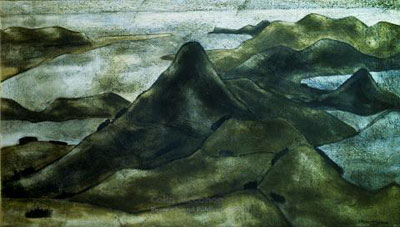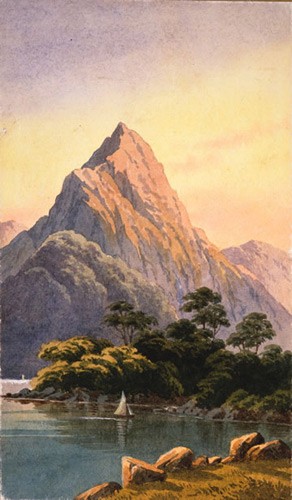
Harbour Cone from Peggy’s Hill, 1939 Courtesy of the Colin McCahon Research and Publication Trust
In 1940 the Otago Society of Arts (of which McCahon was a member) refused to hang the above painting. Apparently they felt that it challenged their idea of what good art was, but a group of fellow artists supportive of McCahon stood by him and refused to have their works displayed in protest. In response, the society backed down, and allowed McCahn to display his works.
Again, this work is pared back, it's almost like a monochrome print, and there is very little colour of vitality in it. The work depicts the form as rustic and raw, conveying once again the aloneness and isolation of Aotearoa, our separation from the rest of the world. That the Otago Society of Arts was offended speaks volumes, their ideal back then, along with the era, would have been conservative, stodgy, 'beautiful New Zealand' landscape paintings, representing a colonial, European, very British and very idealised, photographic New Zealand.
McCahon was always interested in painting Aotearoa afresh, and throughout his career he spurned the old maxims of more traditional painting. The above is a fairly early work in McCahon's career, and is quite different from his later works. There is a softness of tone and a lovely gradation of sombre, muted tonal colours and a print-like quality to the work.

Mitre Peak in Milford Sound, Fiordland, has been painted many times. This 1870s image by John Barr Clark Hoyte or J.C. Hoyte (1835–1913).
I have included the image of the above painting, by traditional New Zealand painter, John Ban Clark Hoyte, in order to compare with the post modernist, utterly opposite style of McCahon. The above work is in a more classical, traditional style, beautifying the subject, making it picture-postcard like and idealising the subject. it is in stark contrast to McCahon's immediate, bold, pared back style, but John Ban Clark Hoyte, the painter was from an earlier, pre-photographic era. The New Zealand narrative is, like all narratives, constantly under-going change. The above painting is more of the Romantic era, with its prettified, idealised, softened, calendar-like view, pertaining to the very British, Colonial, European, 'superior' master narrative that permeated and was typical of this young and emerging era in New Zealand's/Aotearoa's history.
In 1940 the Otago Society of Arts (of which McCahon was a member) refused to hang the above painting. Apparently they felt that it challenged their idea of what good art was, but a group of fellow artists supportive of McCahon stood by him and refused to have their works displayed in protest. In response, the society backed down, and allowed McCahn to display his works.
Again, this work is pared back, it's almost like a monochrome print, and there is very little colour of vitality in it. The work depicts the form as rustic and raw, conveying once again the aloneness and isolation of Aotearoa, our separation from the rest of the world. That the Otago Society of Arts was offended speaks volumes, their ideal back then, along with the era, would have been conservative, stodgy, 'beautiful New Zealand' landscape paintings, representing a colonial, European, very British and very idealised, photographic New Zealand.
McCahon was always interested in painting Aotearoa afresh, and throughout his career he spurned the old maxims of more traditional painting. The above is a fairly early work in McCahon's career, and is quite different from his later works. There is a softness of tone and a lovely gradation of sombre, muted tonal colours and a print-like quality to the work.

Mitre Peak in Milford Sound, Fiordland, has been painted many times. This 1870s image by John Barr Clark Hoyte or J.C. Hoyte (1835–1913).
I have included the image of the above painting, by traditional New Zealand painter, John Ban Clark Hoyte, in order to compare with the post modernist, utterly opposite style of McCahon. The above work is in a more classical, traditional style, beautifying the subject, making it picture-postcard like and idealising the subject. it is in stark contrast to McCahon's immediate, bold, pared back style, but John Ban Clark Hoyte, the painter was from an earlier, pre-photographic era. The New Zealand narrative is, like all narratives, constantly under-going change. The above painting is more of the Romantic era, with its prettified, idealised, softened, calendar-like view, pertaining to the very British, Colonial, European, 'superior' master narrative that permeated and was typical of this young and emerging era in New Zealand's/Aotearoa's history.


No comments:
Post a Comment